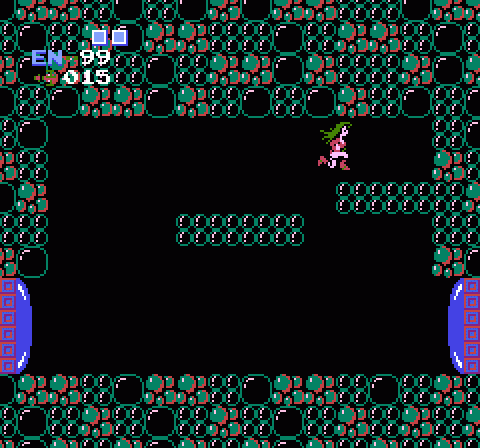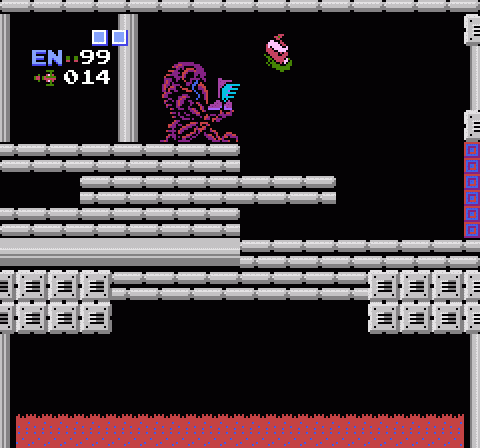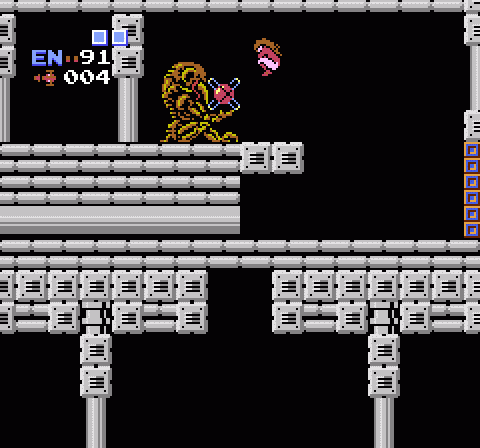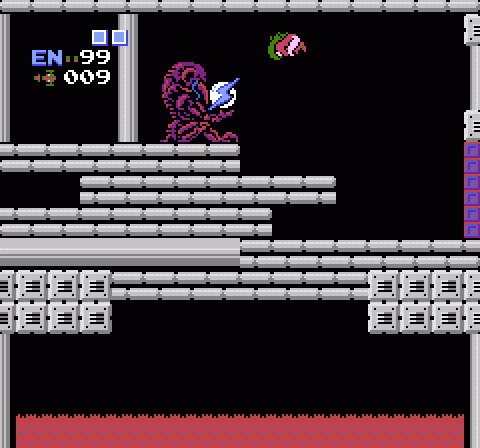Metroid did a lot of really innovative and interesting things for a game of its genre and period, but perhaps the most important idea it brought to the table was the concept of power-up permanence. Samus didn’t simply collect items that made her more powerful; once she acquired them, she kept them. The only impermanent additions to her arsenal were her beam modifiers and her Missiles. The Ice Beam and Wave Beam could be swapped for one another if you ran back to collect the replacement, while Missiles were a limited, expendable resource — yet even then, upgrades permanently increased her Missile carrying capacity, and enemies would drop bits of energy to allow Samus to recharge her Missile tally.

The concept of collecting gear to permanently boost your avatar’s abilities didn’t begin with Metroid, of course. Role-playing games had it more or less from the start. So did adventure games like Zork. Even action-RPG hybrids like The Legend of Zelda (which launched a few months before Metroid) and Tower of Druaga drew on the concept of equipment and left you far more powerful at the game’s end than at the beginning.
For a platform-style side-scrolling action game, however, this sort of permanence hadn’t really been explored before. For starters, the side-scroller had only gotten its proper kick-off about a year before, so the games that Super Mario Bros. inspired were only beginning to come to market around the time Metroid launched. But more to the point, that particular style of game still existed within an arcade-oriented mindset. They were meant to be brief, exciting, challenging adventures. Metroid, on the other hand, beckoned players with a huge, interconnected labyrinth that eschewed multiple stages in favor of a few regions that heroine Samus Aran could freely traverse provided she had the proper tools for the job. While Metroid didn’t scrimp on its challenge level, the challenge that it presented was a different sort than action games normally went in for.
Thus the standard ephemeral power-ups established by Pac-Man‘s energizer pellets and Donkey Kong‘s mallets would have been a poor fit for the needs of Metroid. Its world possessed a level of persistence unusual for that style of game, with scenery designed to be explored and covered repeatedly rather than dashed through in a linear rush to the end. So when Samus acquired a new power, she kept it.
Even more impressively, Samus’ add-ons didn’t just modestly tweak her combat capabilities, they multiplied her strength considerably. The fragile little soldier at the beginning of the game, with that sad little short-distance beam and nothing to her name but 30 points of health, became a deadly dervish of offensive power by the end. Even Samus’ body itself becomes a weapon with the correct weapon equipped.
What I find most interesting about Samus’ gear is that it becomes so seamless. Despite its scope and complexity, Metroid doesn’t include a sub-screen. There’s no in-game map (and I do wish that I still had the stunningly amazing graph paper maps I created for the game back in the day), and you can’t juggle inventory. Besides the Ice and Wave Beams, Samus’ powers are cumulative, each stacking on the other. And nearly every ability she gains increases both her combat efficacy and her ability to navigate Zebes’ rocky chambers — only a few do only one or the other.

I’ve written about the Bombs, Ice Beam, and Missiles already, as they serve as the fulcrum for Samus’ exploration. The other abilities she can collect throughout the course of her adventure, though technically optional, can be just as useful. The High Jump boots make the game massively easier, not only because they allow easier traversal of the game world without requiring the Ice Beam, but also because they allow you to leap out of certain lava pits (such as the sides of Kraid’s chamber) that the sticky liquid physics prevent you from clearing on your own. The Energy Tank secretly hidden in the wall of Kraid’s room is pretty much impossible to collect without High Jump, and I can’t imagine trying to navigate the final escape sequence without them.

The Varia is actually the most difficult item to acquire in the entire game. Unless you’re very clever or simply abuse a bug, you need the Maru-Mari, the Bomb, High Jump, and the Ice Beam in order to reach the room where the Varia is hidden. (It is possible to get there legitimately without High Jump by drawing the Waver in the lower part of the room into the hidden upper chamber and freezing it to use as a stepping stone. But it’s a lot of trouble.)
This complexity is justified by the fact that the Varia doubles Samus’ survivability, reducing the impact of enemy attacks by 50%. It essentially doubles your health, and clearing the Mother Brain’s lair at the very end of the game without the Varia is a truly difficult task. It can be done, though, and if you’re good enough you’ll learn that Samus’ natural hair color when she’s out of her suit is brown, not green, as seen in the screen above — the Varia turns it green, the way it turns her yellow space suit white. This is one of my favorite little details of the game, the fact that Samus has a different color palette for completing an experts-only task that few would ever attempt. Once you acquire the Varia, you keep it forever, even in replays, meaning you have to finish the game quickly without the Varia to be able to see her true hair color.
Before there were Platinum Trophies and 200-Gamer Point Achievements, there was brunette Samus.

And finally, the single coolest weapon in the game: The Screw Attack. The Screw Attack gives justification to the game’s odd, difficult-to-control jumping physics. More than that, it forces you to master her unique jumping properties. See, when Samus jumps while you’re pressing forward on the D-pad, she does a rapid acrobatic spin that causes her movement to feel slightly slippery, especially upon landing. If you press the jump button without moving, she’ll leap straight up without flipping, which makes her easier to control.
Once you have the Screw Attack, though, Samus’ tricky flip becomes an asset: While spinning, her body discharges energy that destroys practically anything she strikes. She’ll pass unharmed through invincible enemies, while everything else save the bosses will instantly explode upon contact. The weird jump that before seemed so detrimental turns into a bold weapon, and avoidance becomes less valuable than jumping headlong into foes. It totally changes the way you play Metroid, and creates a different mentality to action games, period.
The Screw Attack really makes the permanence of Metroid‘s weapon selections interesting. Unlike Pac-Man’s energizers or Mario’s Star Man, the Screw Attack allows you to destroy enemies on contact at any time, not for a few brief seconds while a special jingle plays. Rather than limiting this power by time, Metroid imposes a skill limitation on it: Your invincibility only works in specific situations and requires you to master the game’s tricky jumping physics. Because of this — and because the point of Metroid is discovery rather than simply surviving a dash to the game’s end — the Screw Attack doesn’t break the game.
Metroid doesn’t suddenly become a cakewalk once you acquire it; after all, you still need to find the path to the end and figure out how to best the game’s toughest foes. What the Screw Attack does, however, is make the process of discovery far less of a chore, allowing you to reach your destinations and search for new passages without having to gun down enemies one by one, over and over again. It’s perhaps the most subtle example of Metroid‘s unique approach to facilitating both combat and traversal at all once… which perhaps explains why the Screw Attack symbol has gone on to become an icon of the series.
I was just reading part of a dissertation by a Ph.D. music composition student from the UK, which addressed issues of musical scoring in video games… and I must admit, your articles on game design/anatomy have been much better-written. It’s a shame that legitimate discussion of the medium isn’t where it needs to be yet, but I’m glad to see someone doing a solid job of it. Keep up the good work!
Also, I was apparently incorrect on the energy thing; you’re forced to start every sitting with 30 energy in both the US *and* Japanese versions. I did find out, though, that the escape sequence at the end has a disk side switch immediately following it… kind of breaks the tension of the moment.
This discussion isn’t legitimate!?
Alan, if you want some academic discussion of video game music that’s well-spoken, try digging up the old “Into the Score” podcast by Kenley Kristofferson. It’s good stuff, though I think it hasn’t updated in a couple years, sadly.
I’m curious: You mention the lack of subscreens, and how everything just integrates here. Any thoughts on how later games do it, with even the beams stacking, and being able to turn items on or off, or switching weapons (Plasma and Spazer in Super Metroid) to different effects? Is there any sort of preference there, for any reason?
As an aside, I wish more Metroid games had the “play as Samus out of her suit” reward… as in, any of them. No, Zero Suit Samus in Zero Mission doesn’t count- I hate that part besides.
Incidentally, I wonder at what point Nintendo decided that all their biggest lead females need to be blonde? I miss red/brown-haired Peach, and I’ve seen some neat Samus pics and cosplay with green hair that didn’t seem like it was trying to be anime-ish. At least Twilight Princess’s Zelda had brown hair. And I guess we have Palutena for green now.
Oh, and regarding the Varia: Might have just been my TV, but the suit looked more like a pale skin tone than white to me.
I think Alan meant legitimate discussions as yours are not at academic circles where he wants them to be!? Ph.D. J. Parish!
Thanks for the awesome anatomy series. Honestly, you could pen a book on this stuff and I would buy it. As you know it’s especially relevant to me since Axiom Verge is so heavily inspired by the original Metroid (and Super Metroid). I’ve always preferred permanent upgrades to temporary ones; I think this is one of the off-putting elements of Cave Story to me - I wanted to keep my upgrades. I’m also trying to put a lot of different weapons in my game so that instead of finding missile expansions everywhere, you often find entirely new weapons (though I there are generic upgrades out there too, in order to keep the weapons feeling special).
LBD, when you play Metroid Prime 2 and go into the dark world, you can pretend Samus is out of her armor because she’s constantly taking damage from the poisoned air.
As for the original game, I Screw Ridley every chance I get! It saves the burden of collecting missiles!
Eh, considering it’s primarily a visual thing, I don’t think playing “make-believe” really addresses it here.
It’s possible I missed something in the reading(s), but your last Anatomy article seemed to end on a cliffhanger, mentioning Metroid’s most unintuitive secret. What is, in fact, that secret?
Yeah, I was going to write about bombing holes in non-intuitive spots, but I decided to do the integral weapons write-up first.
@Nikuru: I assumed he was talking about blowing holes in the floors of vertical shafts that look in no way suspicious in tile construction.